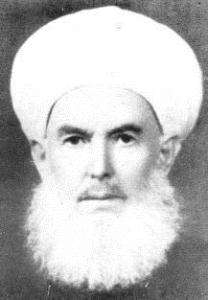Abdullah Fa'izi ad-Daghestani
Abdullah Fa'izi al-Daghestani (December 14, 1891 – September 30, 1973), commonly known as Shaykh Abdullah, was a Daghestani shaykh of the Naqshbandi-Haqqani Sufi order.
Abdullah Fa'izi al-Daghestani | |
|---|---|
 Shaykh Abdullah | |
| Born | December 14, 1891 |
| Died | September 30, 1973 (aged 81) |
| Occupation | Sufi Shaykh, Former leader of the Naqshbandi-Haqqani Sufi Order |
Early life
He was born in the Caucasian region of Daghestan, then colony of the Russian Empire, in 1891.[1][2] Both his father and elder brother were medical doctors, the latter being a surgeon in the Imperial Russian Army. Shaykh Abdullah was raised and trained by his maternal uncle, Shaykh Sharafuddin Daghestani (1875–1936).[2]
Move to Ottoman Turkey
In the late 1890s Shaykh Abdullah's family emigrated to the Ottoman Empire, following his uncle shaykh Sharafuddin who had emigrated in the 1870s.[1] They settled in the northwestern Anatolian city of Bursa and then, after a year, moved to Reşadiye, now known as Güneyköy, Turkey. A new village was established that was populated by Daghestani refugees. Shortly thereafter, Shaykh Abdullah’s father died, and at the age of fifteen, he married a Daghestani named Halima.
Training in Sufism
| Part of a series on Islam Sufism |
|---|
|
List of sufis |
|
|
In 1910, after merely six months of marriage, Shaykh Sharafuddin ordered Abdullah into sacred seclusion (khalwat) for five years. This practice included severe austerities that were intended to raise his spiritual rank. When Abdullah returned to secular life the Ottoman Empire was embroiled in the First World War. Along with many young men of his village, Abdullah entered military service and took part in the Battle of Gallipoli. During a firefight he was severely wounded by enemy fire.
In 1921, Abdullah was instructed by Shaykh Sharafuddin to enter another five years seclusion. He completed this and was then granted a license, or ijazah, to be a master, or shaykh, in the Naqshbandi order.[1][2]
Interlude in Egypt
Because of anti-Sufi regulations in the new Turkish Republic, Shaykh Abdullah began to contemplate leaving the country. After the death of Shaykh Sharafuddin in 1936, a delegation came to Reşadiye from King Farouk to pay their condolences, as he had many followers in Egypt. One of Shaykh Abdullah's daughters married a member of the delegation. Shaykh Abdullah and the family then moved to Egypt, though they would remain there for only half a year as the marriage soon ended in divorce.[1]
Life in Syria
Following his daughter's divorce, Shaykh Abdullah and his family then moved to Syria where he would remain for the rest of his life. He resided for a time in Aleppo, moved to Homs and then finally to Damascus near the tomb of saint Sa’d ad-Din Jibawi. There, he established the first tekke for his branch of the Naqshbandi order.
In 1943, he moved to a house on Jabal Qasioun mountain. The house was bought by his first Syrian murid and later one of his deputies in the Sufi order, Shaykh Husayn Ifrini. This house is now the site of his burial shrine and its adjoining mosque.
Death
Shaykh Abdullah died on September 30, 1973, in Damascus. His grave and burial shrine is in Damascus, Syria, at the site of his former home and mosque on Jabal Qasioun mountain.
Notable followers
Among his notable followers were the Sufi shaykhs Nazim al-Haqqani, adil Merlet, Husayn Ifrini, Hisham Kabbani, and Adnan Kabbani. One of his successors, Shaykh Nazim, went on to spread this branch of the Naqshbandi Sufi order to many countries in the world and was considered among the world's most influential Muslims.[3]
Controversy
Dagestani Sufi shaykh Said Afandi al-Chirkawi (d. 2012), former head of another branch of the Naqshbandi Sufi path, denied the legitimacy of the ijaza, or authorization, of Shaykh Abdullah's teacher, Shaykh Sharafuddin.[4]
See also
References
- Böttcher, Annabelle (2006). "Religious Authority in Transnational Sufi Networks: Shaykh Nazim al-Qubrusi al-Haqqani al-Naqshbandi". In Krämer, Gudrun; Schmidte, Sabine (eds.). Speaking for Islam: Religious Authorities in Muslim Societies. Leiden: Brill. pp. 241–268. ISBN 900414949X. Retrieved November 24, 2014.
- 'The Naqshbandi Sufi Way' by Hisham Kabbani. KAZI Publications, 1995.
- "The 500 Most Influential Muslims, 2009-2013". Retrieved 2014-11-23.
- cf. this article, often cited as "proof" where Shaykh al-Chirkawi questions Shaykh Sharafuddin's ijaza therein:al-Chirkawi, Said Afandi. "Tariqas in Dagestan". islamdag.info. Retrieved November 27, 2014.
External links
- Media Library and Live Broadcast of the Haqqani Golden Chain
- Sheikh Nazim's Official Naqshbandi Journal - Exclusive Talks & Webcast as instructed by Sheikh Nazim Al-Haqqani himself
- Film - The Maqam (Burial Residence) and Biography of Grand Sheikh Abdullah al-Faiz ad-Daghastani by Sheikh Adnan Kabbani, produced by Sufi Films